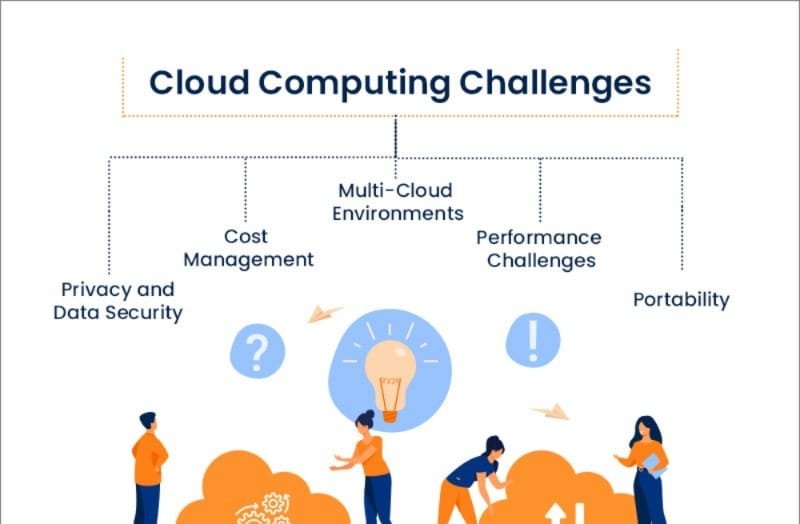Five Reasons Why Cloud Computing Is the Future

Cloud computing is not just a wise decision for forward-thinking companies, but also a need. Almost everyone is aware that cloud computing is a trend in the IT sector that cannot be stopped. That widespread agreement, though, hides a crucial fact: IT businesses vary in where they are in their migration to the cloud.
While some people have embraced the cloud effectively, others are just beginning their exploration and trying to figure out what advantages they can get from cloud computing certification.
The most crucial justifications for an IT business to move to cloud computing are frequently questioned. I’ll list the top five justifications for businesses that are beginning their cloud journeys.
Five Arguments for the Future of Cloud Computing
1. The Cloud Improves Agility and Speed
If there is one essential fact about the corporate climate of today, it is that it is always evolving.
As an illustration, in 2007 the iPod was Apple’s best-selling product and Blackberry dominated the smartphone market. By 2020, Apple was selling more over $110 billion worth of iPhones annually, and Blackberry was merely a name licenced to other phone manufacturers.
Every company is under pressure to adapt to shifting market conditions more swiftly. Unfortunately, modern speed is not well suited for conventional IT processes. Provisioning resources typically takes weeks or months, which slows the business’s reaction time. Resources are instantly accessible with cloud computing, allowing businesses to react to new market developments much more quickly.
DevOps, which realigns software development and deployment to achieve continuous integration and continuous delivery, complements the natural agility of cloud resources. The DevOps CI/CD cycle, which keeps software capabilities, performance, and reliability always up to date and running on an optimum set of resources, is made possible by the cloud.
2. It Fosters Innovation
But speed isn’t the only requirement for success in the modern economic world. Innovation, or the capacity to create novel offerings, assess the likelihood that the market would adopt them, and then introduce the winners while eliminating the failures, is equally important.
Cloud computing is a far better fit than conventional methods for IT infrastructure in this instance as well. It’s simple to test out a new solution right away because resources are made available so quickly. Instead than waiting months for something to enter a market trial, businesses may gain customer input right away.
Additionally, automation on the cloud encourages creativity. It works in conjunction with technologies like low-code and no-code applications to make it possible for a wider variety of individuals to create a wider range of new digital services.
3. It Aids in Cost Management
The outrageous cost of traditional IT infrastructure is another truth. Servers, storage, and a network are physical resources that infrastructure needs. However, there are also significant running costs associated with such resources, including personnel, infrastructure, and power.
Additionally, the majority of IT companies struggle with infrastructure efficiency. Resource costs are high since procurement occurs rarely and in small quantities. Labor expenditures are high because operational activities are often not mechanised.
The large cloud providers, however, make bulk purchases. They can be compared to the Costco of computer supplies. Additionally, they must engage in process automation due to the magnitude of their operations. They just couldn’t pay or hire enough people to manage their hyperscale data centres by hand.
4. It Supports Application Resiliency
Application availability has always been important. But nowadays, accessibility is more important than ever. The reason for this is that more businesses are adopting digital transformation to become digital firms, where their clients and suppliers communicate and collaborate using IT-based tools (e.g., mobile apps).
Application resilience is essential in light of the shift to digital. Simply said, apps must continue to function even if the infrastructure fails.
Most on-premise applications display low resiliency. Because most applications cannot afford redundancy due to the high cost of the equipment (see the preceding section), they incorporate SPOFs (single points of failure). The programme stops working when the infrastructure fails and continues to do so until it is fixed.
5. Your workforce’s future is at stake.
Employees are one group that has realised cloud computing is the future. Nobody wants to be stuck on outdated technology since it limits job opportunities.
Therefore, if you don’t use cloud computing, your staff will assume that switching to a company that does will enable them to advance their careers in the future. Additionally, candidates who are looking for work are unwilling to join an organisation they see as being trapped in the past.
Therefore, it’s crucial to put forward-thinking plans that integrate cloud adoption into action to guarantee that your IT organisation is motivated. It goes without saying that this entails developing the abilities of both present and upcoming employees, which calls for education and training. As always, Simplilearn makes it simple for your staff to pick up cutting-edge cloud computing knowledge.





